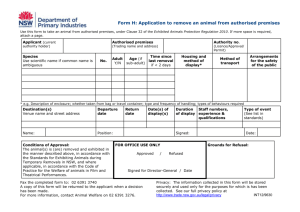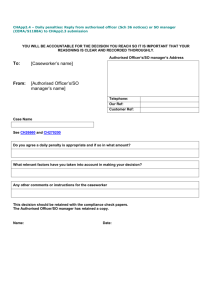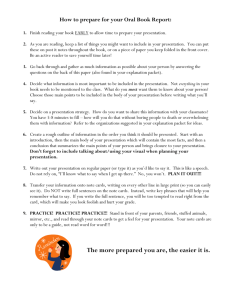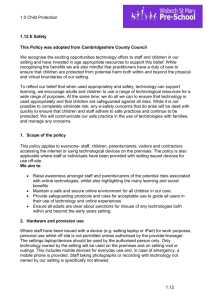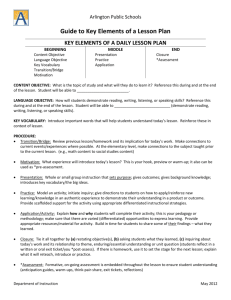food premises closure Jan 22 2014
advertisement
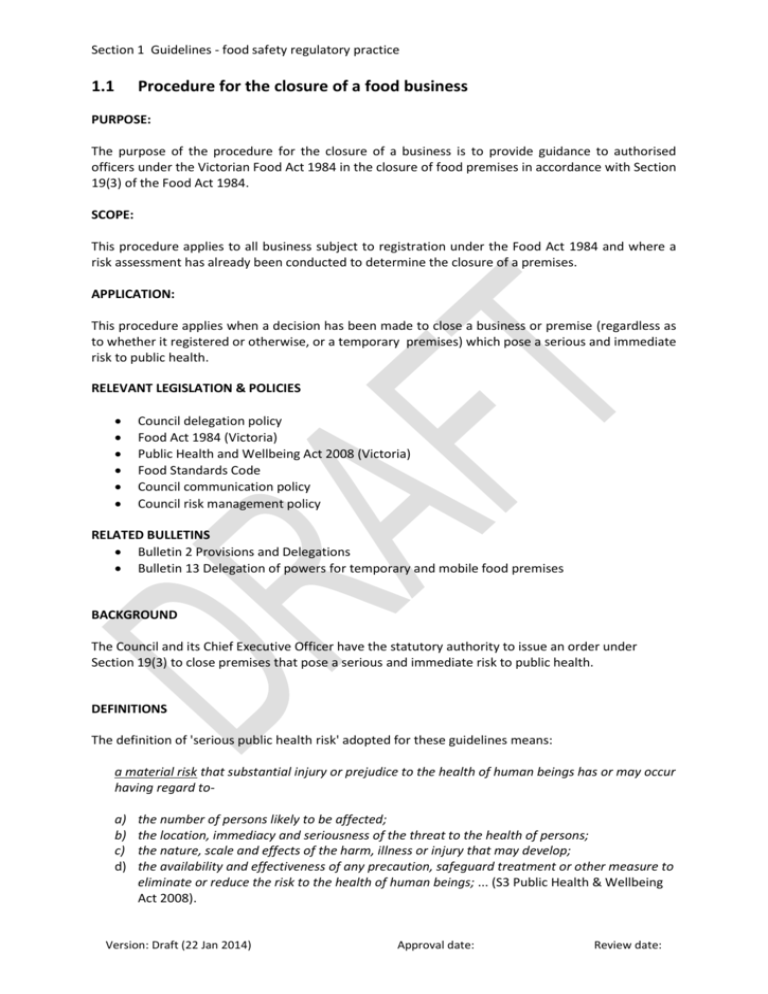
Section 1 Guidelines - food safety regulatory practice 1.1 Procedure for the closure of a food business PURPOSE: The purpose of the procedure for the closure of a business is to provide guidance to authorised officers under the Victorian Food Act 1984 in the closure of food premises in accordance with Section 19(3) of the Food Act 1984. SCOPE: This procedure applies to all business subject to registration under the Food Act 1984 and where a risk assessment has already been conducted to determine the closure of a premises. APPLICATION: This procedure applies when a decision has been made to close a business or premise (regardless as to whether it registered or otherwise, or a temporary premises) which pose a serious and immediate risk to public health. RELEVANT LEGISLATION & POLICIES Council delegation policy Food Act 1984 (Victoria) Public Health and Wellbeing Act 2008 (Victoria) Food Standards Code Council communication policy Council risk management policy RELATED BULLETINS Bulletin 2 Provisions and Delegations Bulletin 13 Delegation of powers for temporary and mobile food premises BACKGROUND The Council and its Chief Executive Officer have the statutory authority to issue an order under Section 19(3) to close premises that pose a serious and immediate risk to public health. DEFINITIONS The definition of 'serious public health risk' adopted for these guidelines means: a material risk that substantial injury or prejudice to the health of human beings has or may occur having regard toa) b) c) d) the number of persons likely to be affected; the location, immediacy and seriousness of the threat to the health of persons; the nature, scale and effects of the harm, illness or injury that may develop; the availability and effectiveness of any precaution, safeguard treatment or other measure to eliminate or reduce the risk to the health of human beings; ... (S3 Public Health & Wellbeing Act 2008). Version: Draft (22 Jan 2014) Approval date: Review date: Section 1 Guidelines - food safety regulatory practice A 'material risk' within the food safety context means if the health of one or more persons has been, or might reasonably be expected to be, harmed by an act or omission resulting in unsafe food (adapted from Section 54(4) South Australian Public Health Act 2011). CLOSURE ORDER PROCEDURE PROCESS FLOW Food Safety Assessment or Inspection (Risk Assessment) Seek Closure Order Serve Closure Order Notify Department of Health Revoke Closure Order Legal Proceedings PROCEDURE 1. Food Safety Assessment or Inspection Process 1.1. If an Authorised Officer is of the opinion that: (a) a food premises is in an unclean or unsanitary condition or in a state of disrepair; or (b) food being prepared, sold or otherwise handled at the food premises is unsafe or unsuitable; or (c) food is prepared sold or otherwise handled at the food premises in a manner that makes it likely the food is unsafe or unsuitable. and if that premises presents an immediate and or serious risk to the health of the public that can not be mitigated immediately (seizing food), then the officer must prepare a report to the Council or CEO for closure of premises in accordance with this procedure. 1.2 The Authorised Officer should call their immediate supervisor to discuss the Authorised Officer's concerns immediately, and arrange for the attendance on-site of a second Authorised Officer (or REHO for assistance). 1.3 The Authorised Officers proceed to obtain the evidence (photographs, samples, written notes, seizure of items) to establish the case for closure. Version: Draft (22 Jan 2014) Approval date: Review date: Section 1 Guidelines - food safety regulatory practice Once the Authorised Officer has suspicion that legal action may be taken, the Authorised Officer is to issue a formal caution to the person in charge. 1.4 If the Authorised Officer is satisfied that the evidence gathered supports the opinion formed in 1.1 then the officers must: (a) inform the proprietor or the person in charge of the food business operating from the food premises, of the outcome of the risk assessment; (b) inform the proprietor or the person in charge of the food business that Council or the Chief Executive Officer (CEO), has the power under the Act to direct that: (i) the food premises must not be kept or used for the sale, or the handling for sale, of any food; or (ii) the food premises must not be kept or used for the preparation of food; or (iii) the food premises must not be used for a specified purpose or for the use of any specified equipment or a specified process. 2. Seek closure Order 2.1 The Authorised Officer prepares a report to the CEO to obtain an order pursuant to section 19(3) of the Act. The report must include all relevant supporting documentation providing reasons as to why a Closure Order under the Act is required. The report must be supported with the following documentation: Inspection reports Photographs Food premises history A copy of the Section 19 order A copy of the closure order for signature Refer to Appendix 2.1 for the template. This report must be submitted to the immediate supervisor and forwarded to the CEO to brief them on the situation. This briefing should be undertaken as a matter of urgency and within a maximum of 24 hours of receiving the information. The CEO will be provided with the report Appendix 2.1 and accompanying information and the Closure Order for consideration and signing Appendix 2.2. 3. Obtain Closure Order 3.1 If the CEO is satisfied that there is a serious and immediate risk to the public, he/she will sign the Closure Order and give it to the relevant Authorised Officer for serving. If the direction is made under part (a) or (b), the CEO may also include a direction that a copy of the Closure Order be affixed to a conspicuous part of the premises in such a manner that the order can be read by a member of the public from outside the premises. Version: Draft (22 Jan 2014) Approval date: Review date: Section 1 Guidelines - food safety regulatory practice 4. Serve Closure Order 4.1 As soon as the Closure Order has been signed by the CEO, the Authorised Officer with the immediate supervisor (or Authorised Officer/REHO) will serve the order in person, on the proprietor/ person in charge of the food business at the business address. The closure order should be obtained and served within a 24 hour period. 4.2 Affix a copy of the Closure Order at the entrance of the food premises and/or publish a notice in the news paper or any other means to inform the public that such an order has been made if directed by the CEO. Refer to Council’s Policy on when and where the Closure Notice should be published in a newspaper or by other means to inform the general public. 5. Notify the Department of Health 5.1 The Authorised Officer must notify should advise the Department of Health’s Food Safety Regulation and Incident Management Unit of the making of the Closure Order. A copy of the Closure Order and Section 19 Notice must be forwarded to the Department of Health Food Safety Regulation and Incident Management Unit. Call the Department of Health for the appropriate contact, their number can be found at the following web address: www.health.vic.gov.au/foodsafety/contacts.htm. 6. Monitor 6.1 Council will undertake regular monitoring of the premises to ensure that the proprietor complies with the requirements of the Closure Order. Authorised Officer to document compliance with the Closure Order. 7. Revocation of Closure Order 7.1 If the Authorised Officer is satisfied that there has been sufficient work undertaken to remove the serious and immediate risk to the public, the Officer must produce a report documenting this Appendix 5.1. 7.2 Where possible, two Authorised Officers should determine if sufficient work as been undertaken/notice has been complied with The CEO will be provided with this report with a draft order revoking the Closure Order (a Revocation Order) Appendix 5.2. If the CEO is satisfied from the report of the Authorised Officer that there is no longer a serious and immediate risk to the public then the Revocation Order will be signed. 7.3 The Authorised Officer will then ensure that this Revocation Order is served on the proprietor or person in charge allowing the business to reopen. The Authorised Officer must serve the Revocation Order on the proprietor of the food business in the same manner in which the Closure Order was served. 8. Legal Proceedings 7.1 Legal proceedings should be considered as per council policy and procedures. Version: Draft (22 Jan 2014) Approval date: Review date: Section 1 Guidelines - food safety regulatory practice Case study – premises on crown land – airport, railway station Version: Draft (22 Jan 2014) Approval date: Review date:
